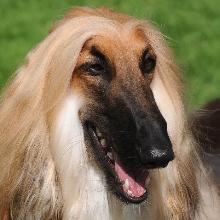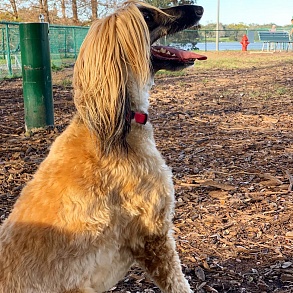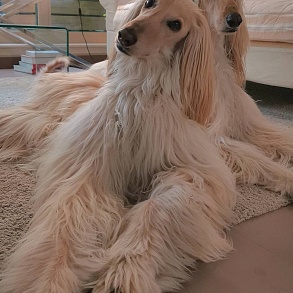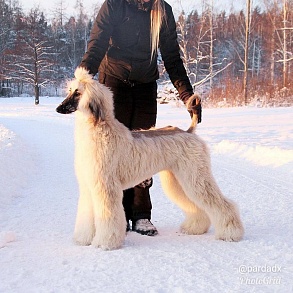Afghan Hound

The Afghan Hound is an ancient breed of long–haired hunting dogs, characterized by increased sensitivity and a calm, peaceful nature.
Brief information
- Breed name: Afghan Hound
- Country of Origin: Afghanistan
- Weight: males 20-25 kg, females 15-20 kg
- Height (height at the withers): males 64-74 cm, females 60-70 cm
- Life expectancy: 11-13 years
Highlights
- In Central Asian countries, the ancestors of Afghan greyhounds were used as hunters and shepherds. Modern representatives of the breed are gradually losing their working qualifications, becoming more and more decorative pets.
- Grooming a dog is time-consuming and requires primary grooming skills, well, or serious financial costs if you trust a professional.
- Compared to other hunting breeds, Afghan greyhounds are difficult to train. They are prevented from becoming "excellent students" by natural stubbornness and a constant desire for independence.
- In everyday life, Afghan greyhounds are affectionate and playful creatures, but their pride is easily hurt. In addition, they quickly become attached to their own owner, jealous of his other pets.
- Both young and quite mature "Afghans" like to chase some small animal. At the same time, cats who grew up in the same territory with a dog are not threatened with such "repression".
- Afghan greyhounds are excellent runners, able to cover huge distances in a matter of minutes, so coursing is their element.
- Today's greyhounds are very different from their relatives living in Afghanistan. For example, dogs of the Western world have lost some of their breed characteristics, including the "saddle" on the back, which has become less pronounced, and prominent eyebrows. At the same time, they got a more stylish "outfit", which the aboriginal Afghan greyhounds never had.
- In the homeland of Afghan greyhounds, in Central Asia, they are called tazi, which translates as "fast-moving".
- Afghan greyhounds have a low pain threshold, because of which even a minor wound causes suffering to the animal.
Afghan Hound is a proud "socialite" who can't stand familiarity, but loves pleasant communication and outdoor games. This is one of the most intelligent breeds, whose representatives you will never see arguing with other dogs over a bone or fighting with their own owner for the status of the head of the house. At the same time, it is only necessary to point the Afghan greyhound at the game, as she immediately forgets about her own high position, turning into a swift and ruthless hunter, from whom no animal will hide.
Breed characteristics
History of the Afghan Hound breed
The official homeland of the breed is Afghanistan, from where it got first to England, and then to the rest of Europe. However, initially the habitat of the animals was not so limited, so the greyhounds lived quite happily on the territories of other Asian states, in particular, in Iran, India and Pakistan.
It is not entirely clear how the ancestors of the Afghan greyhounds penetrated into Central Asia, but experts tend to believe that the animals were brought here by nomads. As an argument, the researchers refer to the ancient name of the breed Tāžī Spay, consonant with the word "tazy", which was once called Kazakh (Turkmen) greyhounds. At one time, this dog clan traveled a lot in Central and South Asia, so it could well spread its genes among Afghans. The Afghan greyhounds are also attributed to the relationship with the saluki, one of the oldest breeds that settled in the lands of the Middle East for several millennia before our era. There is an opinion that it is the saluki that are "to blame" for the division of greyhounds into two main types: steppe – with relatively short hair, and more shaggy – mountain.
In the UK, Afghan greyhounds lit up at the end of the XIX century, arriving there with the military, who returned from service in India. At first, animals were imported as exotic curiosities, with which it was possible to attract attention at various exhibitions and competitions. For example, in 1907, an Afghan dog named Zardin beat the contenders and literally snatched victory at the British Crystal Palace Show. However, the number of dogs grew, and the breeders' interest in them became more professional. As a result: already at the beginning of the XX century, the Afghan hound breed had its first standard, the standard for which was the notorious Zardin.
In the 20s of the XX century, two elite kennels of Afghan greyhounds were opened in England: the establishment of Major Bell-Murray and the Ghazni kennel, owned by the wife of one of the British military - Mary Empes. In the first, animals brought from Pakistan lived and multiplied, while in the second, exclusively "long-haired" Kabul greyhounds were bred. As it often happens, the establishments competed with each other, but soon the shaggy natives of "Ghazni" began to be in greater demand than the wards of Bell-Murray. By the way, later it was the greyhounds from the Mary Empes kennel that were chosen by American breeders for further breeding of the breed in the USA.
As for the modern appearance of the "Afghans", they acquired it only by the middle of the XX century, after the tribal lines of Bell-Murray and Mrs. Empes were crossed. This led to the fact that in 1948 the breed standard of the Afghan greyhound was radically revised and approved in the form in which we know it today.
Video: Afghan Hound
Appearance of an Afghan hound
The Afghan hound is a long–legged aristocrat dressed in a soft "cloak" of light satin wool and stylish "bell-bottomed trousers". Add sophistication to the appearance of the animal and the proud landing of the head, coupled with a regal posture, creating the feeling that you are not just a dog, but a refined person of royal blood. But, of course, the Afghan greyhound looks especially impressive when running: its thick, shiny coat flutters under the gusts of wind, like a mantle, emphasizing the amazing grace of the canine silhouette.
Head
Afghan greyhounds are characterized by an elongated, wedge-shaped skull with an insignificant foot and a raised occipital protuberance. The dog's muzzle is emphatically elongated, dryish.
Jaws and bite
The jaws of the Afghan greyhound are distinguished by a good grip and sufficient strength for a hunting dog. The ideal type of bite for representatives of this breed is full "scissors", but a tick–like variant is also considered acceptable.
Nose
The preferred color of the lobe is black, although individuals with light hair, having a nose of a brown-liver shade, are also not rejected.
Eyes
Almost triangular in shape, set slightly obliquely. Ideally, if the iris of the Afghan hound is painted in dark shades, golden color is also possible, but less preferable.
Ears
This breed has ears set low, pressed to the head, located at a sufficiently remote distance from the front of the skull. The hair on the outside of the ear flap is long and hangs in strands.
Neck
The neck of the Afghan hound is strong, moderately long.
Housing
The dog's body is harmonious, slightly elongated, with an even back, a short, wide loin and a sloping croup in the lower part.
Limbs
The legs of the Afghan hound are strong, without curvature or obvious sweep. The shoulder blades are elongated, retracted. The elbows are tightly pressed to the body, the pasterns are strong, of good length. The hind legs of the dog are more powerful, widely spaced, with normally bent joints. The paws are long and wide (the hind ones are noticeably narrower than the front ones), with arched fingers covered with long strands of wool.
Tail
The tail of the "Afghan" looks somewhat shocking because of the low landing and insufficient growth (the awn is rare, hanging down). In addition, the tip of the tail is twisted into a ring.
Wool
The Afghan hound's coat is the awn covering the muzzle, shoulders, as well as the back area, and undercoat. The awn on the muzzle is quite short, but starting from the forehead, it gradually lengthens and forms a top-knot (a tuft of hair) on the dog's head. The rest of the animal's body is covered with long, soft hair, which, in fact, is nothing more than an abundant undercoat.
Color
Any type of color is regarded as having the right to exist. The most common types of colors of the Afghan hound are: golden, silver, red, white fawn, blue, brindle. The presence of a contrasting mask on the head is also welcome (exceptions are individuals of white, black and black–and-tan color).
Disqualifying breed defects
- Albinism.
- White spots on the fur in the area of the skull.
- Too tall: for males – more than 74 cm; for females – above 69 cm .
- Lower jaw with a misalignment.
- Cryptorchidism.
- Depigmented eyelids, lips.
- Malocclusion.
Character of the Afghan hound
An Afghan hound puppy and an adult dog are two completely different personalities. If the baby is ready for games, hugs and jumping at any time of the day or night, then a mature individual is not capable of such feats. Yes, she also needs a portion of attention and the owner's affection, but only when the dog wants it, and not when the owner comes into his head.
In general, the character of the "Afghans" is similar to that of a cat: they are cute, charming, sociable, but they will not allow anyone to manage their own lives. However, each Afghan hound is a bright personality, and it is extremely difficult to fit all the animals to the same characteristics. For example, among the representatives of this dog family, there are plenty of shy quiet people and wayward whims, so buying an Afghan puppy is always a guessing game. Moreover, no psychic is able to predict exactly what type of temperament and mindset a pet will have, since even babies from the same litter can have absolutely dissimilar characters.
Afghan is touchy. No, not like that. The Afghan is very touchy, and if you risked unfairly punishing him, wait for universal discontent from the shaggy touchy. But there are also cases when the dog does not show that he is upset about something, although he is boiling with indignation in his soul. This is quite normal. Afghan greyhounds, like typical Easterners, are able to mask their own emotions, misleading even the most experienced owners. So if you dream of a dog with a mysterious Asian soul, with this breed you are definitely on the way.
Afghan greyhounds are not inclined to leadership and will never compete with the owner for the "throne and crown". They already know their worth, and therefore do not see the point in proving something to someone. In dealing with strangers, animals are restrained, but they are not aggressive at all. But ill-mannered children can bring a dog to a nervous breakdown: to tolerate violence and annoying pranks of the little ones for Afghan greyhounds is akin to a catastrophe. In addition, they do not tolerate pain well, so that a tail or paw accidentally pinched by a child's foot can become a weighty reason for canine hostility.
Education and training
Among fans of the breed, its representatives have a reputation for being stubborn, and there is some truth in this. Afghan greyhounds are not stupid at all and learn new material one or two at a time, while it is very difficult to get them to clearly execute the command. However, it is wrong to blame only the animals themselves for this. The Afghan hound is a breed that was originally created not to execute orders, but to corral game. Accordingly, no one obliged the ancestors of today's dogs to ask the owner's permission before attacking the beast.
And yet it is necessary to train an Afghan greyhound at least for its own safety. Usually, dog handlers recommend passing with an animal OKD, the basic set of commands of which the city dog has enough for the eyes. There have been infrequent guests at the "Afghans" dressing stations lately: caring for the dog's fur is not so cheap as to sacrifice its cleanliness on the hunt with a light heart. However, it is always interesting and quite realistic to practice walking on a leash in a group of other greyhounds with a representative of this breed.
If you have an Afghan show-class greyhound, you will also have to comprehend the subtleties of her training in the exhibition stand, which should go at a slow pace with alternate use of the command "Stand!" and praise "Good!". While the right position is being formed, the animal needs to be encouraged and stimulated more often. Keep in mind, a young dog should like the way you control his body, otherwise he will interrupt classes and go about his business.
The principles of raising an Afghan hound puppy remain the same as for other breeds. Do not postpone the process of training and socialization of the dog for a long time, starting to instill in her norms of behavior immediately after moving to a new home. Introduce the baby to his personal territory (the place where the couch is), cover the floor with newspapers and diapers in the place where the animal prefers to go to the toilet. In general, do everything that you would do for any other puppy.
Maintenance and care
The issue of ideal housing for Afghan greyhounds still remains unresolved, so while one half of the breeders criticize the conditions of housing, the other quietly places "Afghans" in standard "two-bedroom" and "three-bedroom". It is worth saying, however, that the comfort of living a pet in an apartment largely depends on his temperament. Some greyhounds are calm about the lack of free space, provided that they are well walked. Others, on the contrary, need country apartments with an extensive backyard, where you can chase rodents or neighborhood cats in plenty.
Hygiene
Once the Afghan hound was an unpretentious hunting dog that almost did not require care. However, after the breeders brought out its decorative variety with a hypertrophied undercoat, the owners had more work. Do not forget, Afghan greyhounds do not shed on their own, they need to be helped by combing out dead hairs with a comb and plucking out the undercoat. In addition, the hair of dogs, devoid of natural fatty lubrication, has a peculiarity of being confused. Consequently, if you do not bother with systematic combing, the animal quickly turns into an untidy "felt boots".
The Afghan hound's coat is combed in layers, starting from the bottom and after pre-moistening, since dry hair is extremely fragile and highly electrified. Be sure to work out the tufts of wool between the paws, which often fall off. By the way, the "Afghans" treat their feet with reverence and do not like to be touched, so the sooner you start scratching the puppy's paws, the easier it is for you. The tail of the Afghan hound also needs styling: comb it so that the hair hangs strictly vertically, forming a straight parting in the upper part of the tail.
Up to a year, the hair of puppies grows intensively and practically does not fall out, so it is enough for kids to comb with a brush made of natural bristles about once every 1-2 days. 12-month–old individuals can boast of a fully formed coat: a parting appears on the head, the awn on the back becomes tougher and shorter, and the undercoat on the paws and sides is longer. During this period, a trimming knife is added to the already existing arsenal of combs and combs to treat the back and sagging areas on the sides of the neck. According to the conditions of the breed standard, a classic haircut for Afghan greyhounds is contraindicated, but if you shorten the hair under the tail and armpits, where 90% of the tangles are formed, it will be easier to take care of the dog, and it will look neater (not suitable in the case of exhibition animals).
Too frequent bathing is not good for Afghan greyhounds, so one bath day in several months is enough for an ordinary pet. They wash the animals with diluted veterinary shampoo, then apply conditioner to the wool, wipe it with a towel and dry it with a hairdryer. The ears are washed separately, alternately lowering them into a basin with warm soapy water so that moisture does not get into the ear canal.
An important caveat: do not let the Afghan hound go to bed immediately after the bath, otherwise the wet wool will doubt and lose its airiness. First, dry the dog completely and only then let her do what she wants.
Preparation of the Afghan hound for the exhibition differs from standard care mainly by a set of cosmetics that give the pet's coat a special gloss. Usually the animal is washed on the eve of the event, after which the dried dog is dressed in a protective jumpsuit so that the hair stays clean longer. It is better to protect the strands on the ears with a mesh, and put protective dog shoe covers on the paws, since the skin on them is sensitive and can change the shade from contact with room dust.
Walking and physical activity
Like any hunting breed, Afghan greyhounds need daily emotional and physical relaxation, that is, a good run. Moreover, it is better if it is not an easy jogging in the squares, but a full two-hour workout with a game of catch-up, exercises and communication with other representatives of the dog tribe. If possible, sign up your pet for coursing: and it's nice for him to amuse his instincts, and it's easier for you. In addition, classes will help the animal to give his best and no longer bother you in the apartment with claims to attention.
When taking an Afghan greyhound outside and letting it off the leash, do not lose your vigilance. These oriental beauties like to chase cars and small animals and lose sight of them – it's a matter of a minute. If there is no time or energy for total control, walk your pet in quiet wastelands or fenced territories, from where he will not be able to escape. By the way, Afghan greyhounds are quite jumpy, so make sure that the fence behind which the dog trains is of a suitable height – she will jump over low fences in two counts. Take into account the physiological characteristics of the breed: Afghan greyhounds normally tolerate the dank autumn weather, but suffer in the heat. Accordingly, in the summer heat, it is better to postpone walks to the early morning and late evening.
The end of summer and the beginning of autumn is a difficult period for the owners of exhibition specimens, as this is the season of ripening of burdock seeds, turnip and other thorns. All this "splendor" is perfectly collected by the soft, airy undercoat of the "Afghan" on a walk and rushes into the house. If you do not want to spend your free time extracting garbage from the dog's "mantle", it is better to refuse excursions to autumn meadows and forests, or, alternatively, take your pet out on a leash and plot a safe route yourself.
Feeding
Despite the fact that Afghan greyhounds are selective in food and have an ascetic body type, a standard hunting dog diet consisting of 20% animal protein will suit them. The main types of meat present in the dog's menu are beef, lamb and chicken, and these may be unclaimed waste and trimmings. By-products such as heart and liver are absorbed by Afghan greyhounds no less actively, but since they contain almost no fat, it is not recommended to switch to them completely. The "Afghans" will not refuse chicken broth with wild rice, boiled fish fillet, low-fat cottage cheese and hard-boiled eggs, so periodically pamper them with similar delicacies.
To maintain the health and beauty of the coat, Afghan greyhounds need fats. Pork meat here, of course, will not do, but a piece of fresh interior fat will be very useful. Brain bones are usually not given to show individuals, since holding the treat with a paw and gnawing it, the dog gets dirty and pulls out the hair on the so-called "slippers". But so that the animal does not feel deprived, the bone can be replaced with raw carrots, which at the same time will satisfy the body's need for fiber. Mineral feedings for greyhounds that eat natural food are also necessary. Usually, "Afghans" are mixed with kelp, fish oil, and during the period of active growth – dicalcium phosphate and pharmacy vitamin complexes.
If desired, the Afghan hound can be transferred to a high–quality and balanced "drying" – premium and super-premium. But canned food for dogs is not recommended to abuse. The dog will not be able to get enough of them anyway, since all wet feeds consist of more than half water and, in fact, are low-calorie, and at the same time cost the same as normal "drying".
Health and diseases of Afghan greyhounds
Afghan greyhounds, of course, are not healthy, but they are not frail sissies, whose well-being can be shaken by the slightest draft. Diseases most commonly found in representatives of this breed are intestinal inversion, myelopathy, hypothyroidism and chylothorax. Various kinds of eczema and dermatitis diagnosed in greyhounds are mainly due to poor grooming, so be attentive to your pet. The eyes of "Afghans" are also relatively weak, so there are relatively many individuals with diagnoses of "cataract" and "retinal degeneration".
How to choose a puppy
- Get ready for a surprise: Afghan hound puppies are much inferior in appearance to adult individuals, moreover, the breed is completely invisible in them. Going to the nursery for a four-legged friend, take a club specialist with you, or at least ask for reviews from other buyers about this institution.
- Take a closer look at the curious, frisky kids who, when they see a new person, will definitely try to get to know him by sniffing shoes.
- If possible, inspect the entire litter. Usually there are always one or two puppies in it, inferior in size and fatness to their fellows. This, of course, is not a marriage, but in order to grow worthy Afghan greyhounds from weak toddlers, you will have to spend many times more effort and time.
- If you are afraid of the manifestation of genetic diseases in a puppy, carefully study the pedigrees of both parents. Usually, the risk of hereditary ailments occurs in individuals whose owner practices inbreeding mating.
- Puppies with whom you plan to visit exhibitions, it is better to buy in adolescence, when the main breed characteristics are more clearly visible. If the baby is bought exclusively for home maintenance, then he is ready to move to the new owner's house in 2-3 months.
The price of an Afghan hound
The highest price tag is put up for club puppies from a pair of greyhounds with interchampion diplomas: on average $400 - $500 . Kids of the Afghan greyhound from more modest litters (for example, parents are champions of Russia), as well as without the right of breeding (pet class) they cost from $200 to $300.


